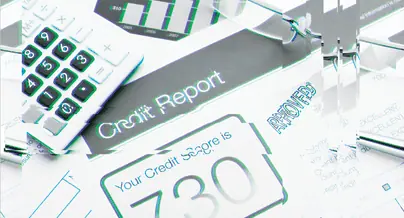
Are There Better Ways To Predict Creditworthiness?

Social media networks-Facebook, Twitter, LinkedIn and the like-create a “digital footprint for each consumer,” says Jeff Stewart, co-founder and chairman of Singapore-based Lenddo, which has an office in New York. “We had a theory that for superior underwriting, we could use this digital footprint to manage risk.” Lenddo uses social media data to prove a customer’s identity and creditworthiness, under the premise that people with the right number of social connections-not too many, but not too few-are more likely to pay back a loan. “There’s a healthy level of social interaction,” says Stewart. The technology company started off making loans in Colombia, Mexico and the Philippines to beef up its algorithm and prove its model. In 2015, Lenddo transitioned from lending to credit scoring, and is now working to establish a foothold in the United States.
To detractors who might scoff at the idea of using a customer’s social profile to prove that person’s likelihood to repay, Stewart argues that the proof is in the pudding. “We sent money to strangers in emerging markets over the internet, and they sent it back with interest,” he says.
Lenddo isn’t the only company examining what social media activity says about a person, specifically that person’s likelihood to repay a loan. Kabbage, a marketplace lender in Atlanta, Georgia, looks at a business’ activity on social media networks, in addition to analyzing revenue and other financial metrics associated with a business.
The traditional credit score isn’t perfect. A Federal Trade Commission study published in 2013 found that one-quarter of consumers-roughly 61 million people-identified errors in their credit reports that could impact their credit scores. Many of the errors remained on these consumers’ credit reports two years later. But historically, it’s a system that has worked for the financial industry. “If I’m trying to understand whether someone’s going to pay their bills or not, what am I likely going to look at first? Whether they repaid bills,” says Dr. Andrew Jennings, senior vice president, scores and analytics at Fair Isaac Corp. (FICO).
However, some consumers don’t qualify for a loan through traditional credit scoring, and some have little or no credit history. Millennials, for example, are less likely to have a credit card. That’s in part due to the Credit Card Accountability, Responsibility and Disclosure (CARD) Act of 2009, which made it more difficult for consumers under the age of 21 to even apply for a credit card. Companies are no longer allowed to set up a stand at universities and offer a free t-shirt or frisbee to anyone that signs up for a credit card. The unintended consequence of this legislation is a generation of consumers with a slim credit file.
More than 50 million Americans don’t have a standard FICO score, and in response, the credit scoring agency has developed an alternative score that includes data such as utility and phone payments. Ten banks have piloted the score.
LendingClub Corp. and Prosper Marketplace, both marketplace lenders headquartered in San Francisco, include FICO scores as part of their overall methodology to determine creditworthiness. But Social Finance-better known as SoFi, and also based in San Francisco-announced in January that FICO scores will no longer be a factor in its underwriting process. SoFi started out refinancing student loans, and has since expanded to personal and mortgage loans. “We just don’t think the score itself is a real driver [of] credit performance,” SoFi CEO Mike Cagney told The Wall Street Journal earlier this year.
SoFi instead looks at variables which include career experience and monthly income. Where the loan applicant attended school matters, too.”They’re unapologetically targeting a very specific segment of the population, which they call HENRYs-High Earners, Not Yet Rich,” says Nick Clements, co-founder of MagnifyMoney, a financial education website. A good example of a HENRY is a graduate from an elite school with a cushy job in a high-end metropolitan area that still needs to pay off substantial student loans.
The model appeals to millennials. SoFi hooks its clients early, underwriting their student loans and then later offering them a mortgage for their first home, with a 10 percent down payment. The lender even has a dating app in the works, based on the premise that financially responsible people have a better chance at marital success, according to a 2015 Federal Reserve study. “The bet that SoFi is making, and these other companies are making, is rather than [having them go] back to big, boring traditional banks, they’re able to steal this generation early, and then own it. And that’s an underwriting-driven piece, where I would say there’s a blind spot in traditional underwriting [at] banks,” says Clements.
“When you take the traditional data that banks have relied on up until now, typically FICO scores, and apply new data to that baseline of traditional data, you’re able to get more insights into who the customer, or this applicant, really is and make credit decisions more rapidly,” says Ryan Gilbert, a partner at Propel Venture Partners, a venture capital firm focused on financial services technology. He’s also a director at Sacramento, California-based River City Bank, with $1.5 billion in assets. “That really ties into this whole concept of democratizing access to credit, which many of the marketplace lenders are speaking about, [in] which they’re saying, ‘You don’t need to be an established client at a bank to get a loan.’”
SoFi examines an applicant’s income and expenses before doling out a personal loan. It’s an approach that makes even more sense for small business lenders such as On Deck, in New York, which analyzes a business’ cash flow to underwrite small business loans. Big banks are warming to this approach. JPMorgan Chase & Co. partnered with On Deck this year, and uses its technology and Chase’s underwriting criteria to offer small-business loans. In May 2016, Wells Fargo & Co. unveiled its own online small-business loan product.
Both promise faster loan approvals. This is possible in part due to the limited client base: Only current Chase and Wells Fargo business clients can apply for loans at their respective banks with the new platforms, so both organizations already have all the information they need to underwrite the loan.
Analyzing cash flows-at least for their own customers-should be a no-brainer for financial institutions. “Banks have much more data about their customers or prospective customers than anyone, more than those online lenders would,” says David Snitkof, chief analytics officer at Orchard Platform, a technology and data firm that connects marketplace lenders with potential investors. But most banks lack the necessary data architecture, suffering from aging, byzantine systems that have been patched together over the years. “Centralization of data and standardization within the bank I think would be very helpful for any bank looking to speed up its modeling and promote innovation,” Snitkof says.
Banks also struggle to attract the necessary talent. If you’re a young data analyst, where do you want to work: The highly regulated, staid traditional bank with outdated technology systems, or the sexy, innovative fintech firm?
“These nontraditional players have teams of data scientists,” says Daryl Jones, a director at Cornerstone Advisors, a consulting firm based in Scottsdale, Arizona. “[Alternative lenders] do a much better job of utilizing the nontraditional data than what banks do.”
Boston-based Eastern Labs, a financial technology unit of $9.9 billion asset Eastern Bank, developed an express business loan, which, similar to Wells Fargo and Chase, is currently available only to current customers of the bank. “We’ve taken a banker’s approach to the platform and the product that we’ve built,” says Dan O’Malley, head of Eastern Labs and chief digital officer at Eastern Bank. The basic approach to loan underwriting remains the same, but now Eastern relies on data science to make the process faster and easier. The new product underwrites the loan using information that is publicly available online-maybe a Yelp review or public filings-along with more traditional information, such as how long an applicant has been in business. And O’Malley says the FICO score, as well as other metrics that prove the customer has a good track record of paying off debt, is still important.
Specialized types of loans require a unique approach to data analysis. The traditional mortgage process often won’t work for clients who are looking to purchase a rental property or flip a house. To underwrite its bridge loans, intended to span the gap between the purchase and sale of a house or until permanent financing is found, LendingHome, in San Francisco, relies on advanced data analytics. How much the property is worth, or how much rent the owner can charge, is a better predictor of whether the applicant will be able to repay this particular type of loan. “You [need] really accurate valuations of the properties,” says CEO Matt Humphreys. If the applicant plans to make improvements, LendingHome will calculate how much money and time that should take, how it will impact the property’s value and whether the applicant has a good track record based on similar past projects. “We’re constantly rebalancing our underwriting criteria,” says Humphreys.
Credit scores rely on past payment behavior. Events that negatively affect a consumer’s credit score can have a lasting impact. “That’s just wrong,” says Zaydoon Munir, CEO of Revolution Credit and a former executive at the credit reporting firm Experian. The data platform, based in Irvine, California, aims to predict future behavior-whether a borrower has the intent and aptitude to repay their loan-through interactive puzzles and games. This use of behavioral economics works alongside a FICO score, and identifies whether someone can qualify for a loan at a slightly better rate.
Bank regulators tend to encourage more access to the banking system, and that includes loans. “The [Consumer Financial Protection Bureau] would very much accommodate some sort of alternative model that is sound, to make sure underserved borrowers are found. That’s why they didn’t use a credit score in the Ability to Repay rule” under the Dodd-Frank Act, says Colgate Selden, counsel at the law firm Alston & Bird. Unsound alternative models could be tagged as “unfair, deceptive or abusive acts or practices”-collectively referred as UDAAPs-under Dodd-Frank.
Snitkof is skeptical of lenders that say their organization uses social media to underwrite loans. “They’re all subject to the exact same fair lending laws,” he says. “You still have to give people an adverse action letter. I don’t believe that many lenders, especially the big ones, are going to use social media data to actually make decisions.” This doesn’t prohibit any company from using information derived via social media to target their marketing campaigns or to prevent fraud, “but I haven’t seen much evidence of it in actual underwriting models,” Snitkof says.
Institutions can’t afford to run afoul of Fair Lending laws by creating a model that inadvertently discriminates against a group of people. In a May 2016 white paper, the U.S. Treasury Department highlighted the underwriting models used by marketplace lenders, indicating the “risk of disparate impact in credit outcomes and the potential for fair lending violations.”
“The question is, how can you build algorithmic models that let you lend to consumers in ways that are okay,” says Eastern’s O’Malley. “Machines can certainly outperform humans when it comes to the prediction of risk, but…we have to decide what inputs we are and aren’t okay with.”
The Treasury Department also questions whether the newer lenders will survive the next economic downturn.
“New business models and underwriting tools have been developed in a period of very low interest rates, declining unemployment and strong overall credit conditions,” warned the department in May. “This industry remains untested through a complete credit cycle.”
A downturn will likely validate the underwriting models of some lenders, while weeding out riskier models, says Bob Ramsey, a senior research analyst at the investment bank FBR & Co.
Loans issued by marketplace lenders with a 36-month term have an annualized charge-off rate of roughly 5 percent, says Snitkof. For commercial banks, the charge-off rate for consumer loans hovers around 2 percent, per the Federal Reserve, and less than 1 percent for total loans and leases.
Propel’s Gilbert argues that the traditional underwriting models used by many banks didn’t hold water during the most recent downturn, and credit models need to evolve. “The 2008 downturn was driven by many of the same credit models that banks are still using today,” he says. In his view, “many banks are going to be in for a big surprise when the next downturn comes.”

Join OUr Community
Bank Director’s annual Bank Services Membership Program combines Bank Director’s extensive online library of director training materials, conferences, our quarterly publication, and access to FinXTech Connect.
Become a Member
Our commitment to those leaders who believe a strong board makes a strong bank never wavers.



